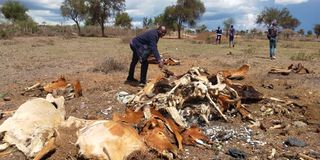How African insurance industry can respond to climate change

Simon Kisipan points at a heap of livestock carcases at Ekinye Village in Kajiado East on December 9, 2022.
Does climate change transition rank as a priority in Africa? Is the drive to transition from brown economy to green economy anchored into every economic sector? Does the insurance industry have a role to play in this transition? What are the specific challenges faced, particularly in sub-Saharan Africa? What proportion of Africans utilise insurance in the first place?
The evidence of changing climates is indisputable. Natural disasters have become far bigger than in the past. In sub-Saharan Africa, typhoons have extended their destructive bounds northward as far as Malawi and southern Tanzania from Mauritius, Madagascar, South Africa, Zimbabwe and Mozambique. Drought has become almost continuous in the Horn of Africa, wiping out the livelihood of nomadic pastoralists in Ethiopia, Somalia and northern Kenya.
The pernicious impact of almost permanent drought tracks westward throughout the Sahel belt countries, including Mauritania, Burkina Faso, Mali, Niger, Chad and Sudan. In the last 50 years, Lake Chad has shrunk from 25,000sq-kms to 2,500sq-kms, causing an upheaval in its wetland ecosystems shared between Nigeria, Niger, Chad and Cameroon.
The Great Rift Valley lakes have experienced increased water levels which have baffled scientists, ruined tourism investments and shifted ornithological migratory patterns. Population migration and displacement, truncated livelihoods, conflict for land and livestock, insecurity and possible political instability are the outcomes.
The threat that changing climate poses to human life has given rise to climate change initiatives and champions. These have been led by Western countries and the United Nations. Both Unep and UNDP are active in climate change initiatives. The initiatives aim at cutting emissions, pursuing nature-based solutions, extending sustainable energy and investing in resilient urban areas. This is aligned with causes of climate change, which are agreed to be the burning of fossil fuels, manufacturing of goods and deforestation.
Under the Paris Agreement, all countries have committed to undertake collective action to hold a global average temperature to well below 2°C above preindustrial levels and optimally to no more than 1.5°C above preindustrial levels. African countries have outlined bold aspirations to build climate-resilient and low-carbon economies in the National Determined Contributions (NDCs) to the Paris Agreement.
The African Development Bank has estimated that the continent needs $500 billion of climate finance by 2030. Africa will need to invest more than $3 trillion in mitigation and adaptation by 2030 in order to implement its NDCs. These commitments are anchored on access to adequate financial technical and capacity-building support. How long will this take to develop if indeed the funds will be forthcoming?
Much of the threat brought about by changing climates is systemic and non-linear. This means that mathematical models that inform sustainable insurance pooling are challenged. In other words, the insurance industry cannot commercially provide large-scale solutions and products until sustainable models and pricing have been developed. Indeed, the government has the responsibility of ensuring that acceptable capital adequacy ratios are maintained by insurers so as to serve the insuring public effectively. The good news is that the development of sustainable models can evolve from the collaboration of stakeholders.
The stakeholders are the insurance industry, government and multilateral partners such as the World Bank and the United Nations. Their collaboration is even more critical in a continent where insurance penetration and per capita is low. The typical African has not insured his property be it his home, livestock or his crops. Collaboration with the government can introduce incentives for management and avoidance of risk and risk mitigation. It can introduce alternative capital into the industry from investors with more risk appetite. It can create specialist insurance pools and consortia that mobilise funding, afford scale and scope for otherwise uninsurable risk.
Africa should not expect a flood of funds from outside to solve African problems. The compelling urgency of the crisis should spur urgent strategy development with a home-grown emphasis on offering appropriate frameworks of climate change insurance laws and regulations. The specialist pools will progressively develop sustainable business models that will integrate with other economic sectors in greener economies.
Mr Wandera is a chartered insurer




